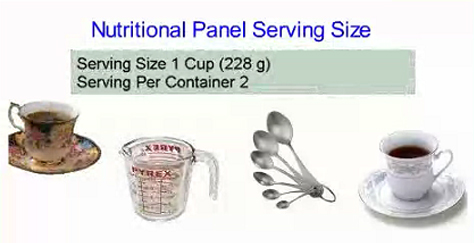
What is the "right" Serving Size?
- First Step: Determine your food category using the Reference Amount Customarily Consumed (RACC) tables. Click here to go to [table 1] , [table 2] - both tables can also be found on the www.gpoaccess.gov site.
- Second Step: Determine appropriate serving size. If your product is sold in small units it is required to be labeled as single serving container. Labeling requirements for single-serving containers can be found here 21 CFR 101.9(b)(6).
- Third Step: Determine the number of serving for your food package.
Common Household Measures
21 CFR 101.9(b)(5)(5)For labeling purposes, the term common household measure or common household unit means cup, tablespoon, teaspoon, piece, slice, fraction (e.g., 1/4 pizza), ounce (oz), fluid ounce (fl oz), or other common household equipment used to package food products (e.g., jar, tray). In expressing serving size in household measures, except as specified in paragraphs (b)(5)(iv), (b)(5)(v), (b)(5)(vi), and (b)(5)(vii) of this section, the following rules shall be used:
(i) Cups, tablespoons, or teaspoons shall be used wherever possible and appropriate except for beverages. For beverages, a manufacturer may use fluid ounces. Cups shall be expressed in 1/4- or 1/3-cup increments. Tablespoons shall be expressed as 1, 1 1/3, 1 1/2, 1 2/3, 2, or 3 tablespoons. Teaspoons shall be expressed as 1/8, 1/4, 1/2, 3/4, 1, or 2 teaspoons.
(ii) If cups, tablespoons or teaspoons are not applicable, units such as piece, slice, tray, jar, and fraction shall be used.
